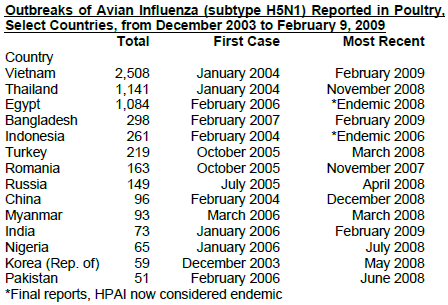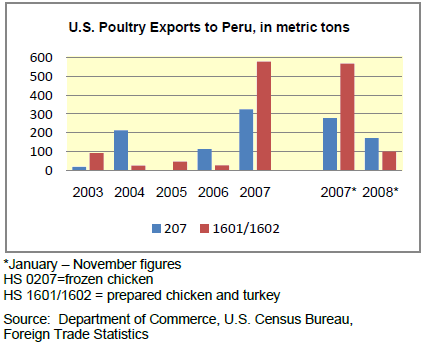



International Egg and Poultry Review
US - By the USDA's Agricultural Marketing Service (AMS). This is a weekly report looking at international developments concerning the poultry industry. This week's report focuses on avian influenza in various countries and the FTA signed between the US and Peru.Highly Pathogenic Avian Influenza H5N1
In the first few weeks of 2009 four countries reported outbreaks of high path avian influenza H5N1 in poultry (Vietnam, Bangladesh, India, and Nepal). Between the start of the chain of outbreaks in December 2003 up to 20 January 2009, 62 countries reported H5N1 avian influenza in domestic poultry/wildlife. A total of 50 countries reported H5N1 in domestic poultry.
A timeline for the current chain of Highly Pathogenic Avian Influenza H5N1 began when H5N1 reappeared in Asia in December 2003, when South Korea reported an outbreak in domestic poultry. In January 2004 Thailand, Cambodia, Japan, Laos and Vietnam reported first outbreaks of H5N1 in domestic poultry, while Hong Kong reported an outbreak in wildlife. In February 2004 China and Indonesia reported first outbreaks, followed by Malaysia in August, 2004.
In July, 2005 Russia became the first European country to report finding H5N1 in domestic poultry. The virus also spreads to additional Asian and European countries in 2005 before reaching Africa in February, 2006. The last country to report an initial outbreak of H5N1 was Togo in June, 2007. On 16 January 2009 Nepal reported an outbreak of H5N1 in backyard poultry, the first case of H5N1 since 1996.

A United Nations study concluded there were fewer outbreaks of H5N1 avian influenza between January and June 2008, and fewer infected countries compared to the same period in 2006 and 2007. From January - September 2008 there were no newly infected countries, compared to 4 newly infected countries in the first six months in 2007. Analysis revealed that several countries had succeeded in eliminating infection through effective surveillance, prompt detection and rapid response.
Other countries have not been successful. Three countries (Egypt, Vietnam and Indonesia) consider H5N1 HPAI endemic, and H5N1 HPAI is entrenched in India and Bangladesh. Sporadic reports of LPAI (low path) have been reported in several countries. Winter is normally the peak season because cold weather favors virus survival.
Source: World Organization for Animal Health (OIE); World Health Organization; UN and World Bank Synopsis of the Fourth Global Progress Report System; UN News Service; Center for Infectious Disease Research & Policy; news wires
US – Peru FTA
US Trade Representative Susan C. Schwab announced that with the President’s issue of a proclamation to implement the US – Peru Trade Promotion Agreement as of 1 February 2009.
The Agreement was signed in 12 April 2006, approved by the US House of Representatives on 8 November 2007, and by the US Senate on 4 December 2007.President Bush signed the legislation implementing the Agreement on 14 December 2007.
The US-Peru FTA will grant duty free access to two-thirds of US food and agricultural products and all tariffs will be eliminated in 17 years. The Agreement will allow imports of previously banned products, such as poultry, pork and beef. Access under TPA includes a quota of 12,000 MT for chicken leg quarters, two years linear for mechanically deboned chicken meat and five years linear for poultry offals.
Chicken is a staple product in the Peruvian diet. Poultry per capita consumption is 30 kg per annum. Since June 2008, chicken meat prices have increased 16 per cent. This situation has taken the government to take a close look at poultry production costs and prices to keep this chicken-dependent inflation under control. Peruvians spend 10 per cent of their food money on poultry.
There are about 20 poultry operations in Peru, which control about 1,000 arms. Peru produces about 33 million chickens per month and the market size for 2008 is estimated at $1.2 billion. The poultry industry is expected to grow 6 per cent in 2009, however demand is expected to grow 11 per cent.
Poultry imports increased at an average annual rate of 32 per cent from 2004-2008 with a 9 per cent import tariff and imported an estimated 11,500 MT of chicken valued at $11 million in 2008. The Ministry of Agriculture has been evaluating importing chicken leg quarters from Brazil or the US, but the Peruvian chicken market is broadly fresh and the c.i.f. prices are around $2.36 per kilogram, which leaves no room for marketing and distribution expenses, or for any profit.
Source: USTR News Release; USDA Foreign Agricultural Service Attaché reports

Further Reading
| - | You can view the full report by clicking here. |
| - | You can visit the Avian Flu page by clicking here. |











